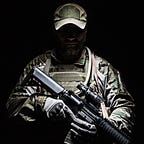Tactical Combat Casualty Care[TCCC]
(TCCC)Tactical Combat Casualty Care are the United States military guidelines for trauma life support in prehospital combat medicine, designed to reduce preventable deaths while maintaining operation success.
The TCCC guidelines are a set of evidence-based best practice guidelines for battlefield trauma care that have been developed over more than 18 years of war.
The three objectives of TCCC are to provide lifesaving care to the injured combatant, to limit the risk of further casualties, and to help the unit achieve mission success.
- Treat injured combatants
- Limit the risk of further casualties
- Achieve mission success
In TCCC prehospital battlefield care is divided into 3 phases:
1. Care Under Fire (CUF)
CUF is characterized as the care rendered to a casualty while still under effective fire. In this case, the first action is to return fire and take cover as fire superiority over the enemy is the best medicine to include the casualty remaining engaged if able. As an enemy is suppressed, casualties can move or be moved to more secure positions. The only medical treatment rendered in CUF is stopping life-threatening hemorrhage (bleeding). TCCC actively endorses and recommends the early and immediate use of tourniquets to control massive external hemorrhage of limbs. All other treatment should be delayed until the casualty can be moved to a more secure and covered position and transitioned to tactical field care.
2. Tactical Field Care (TFC)
TFC is care rendered by first responders or prehospital medical personnel (primarily medics, corpsman, and pararescuemen) while still in the tactical environment. TFC is focused on assessment and management using the MARCH acronym.
- Massive hemorrhage is managed through the use of tourniquets, hemostatic dressings, junctional devices, and pressure dressings.
- The Airway is managed by rapid and aggressive opening of the airway to include cricothyroidotomy for difficult airways.
- Respirations and breathing is managed by the assessment for tension pneumothorax and aggressive use of needle decompression devices to relieve tension and improve breathing.
- Circulation impairment is assessed and managed through the initiation of intravenous access followed up by administration of tranexamic acid (TXA) if indicated, and a fluid resuscitation challenge using the principles of hypotensive resuscitation. TCCC promotes the early and far forward use of blood and blood products if available over the use colloids and discourages the administration of crystalloids such as normal saline (sodium chloride).
- Hypothermia prevention is an early and critical intervention to keep a traumatized casualty warm regardless of the operational environment.
Continued assessment and management in TFC includes treating penetrating eye trauma, assessing for traumatic brain injury or head injuries, treating burns, splinting fractures, and dressing non-life-threatening wounds. TFC culminates with packaging a casualty for evacuation and then evacuating by available air, ground, or maritime assets.
3. Tactical Evacuation Care (TACEVAC)
TACEVAC care encompasses the same assessment and management included in TFC with additional focus on advanced procedures that can be initiated when en route to a medical treatment facility. The caveat of TACEVAC is the evacuation means and care may or may not be dedicated medical platforms such as a MEDEVAC helicopter. TACEVAC can also include the evacuation of casualties on available non-medical assets and the provision of care in such circumstances.
Conclusion
A significant amount of medical literature attests that TCCC is the most viable and reliable methodology to prepare for and manage casualties on the modern battlefield. The TCCC guidelines are routinely updated and published by the Committee on Tactical Combat Casualty Care (CoTCCC). The Current guidelines are available online through the Deployed Medicine site, or through the Joint Trauma System site. They are also reproduced by the National Association of Emergency Medical Technicians websites, the Journal of Special Operations Medicine, and the Special Operations Medical Association.
Need Tactical Medical Gear…? Click the Links Below!!!
